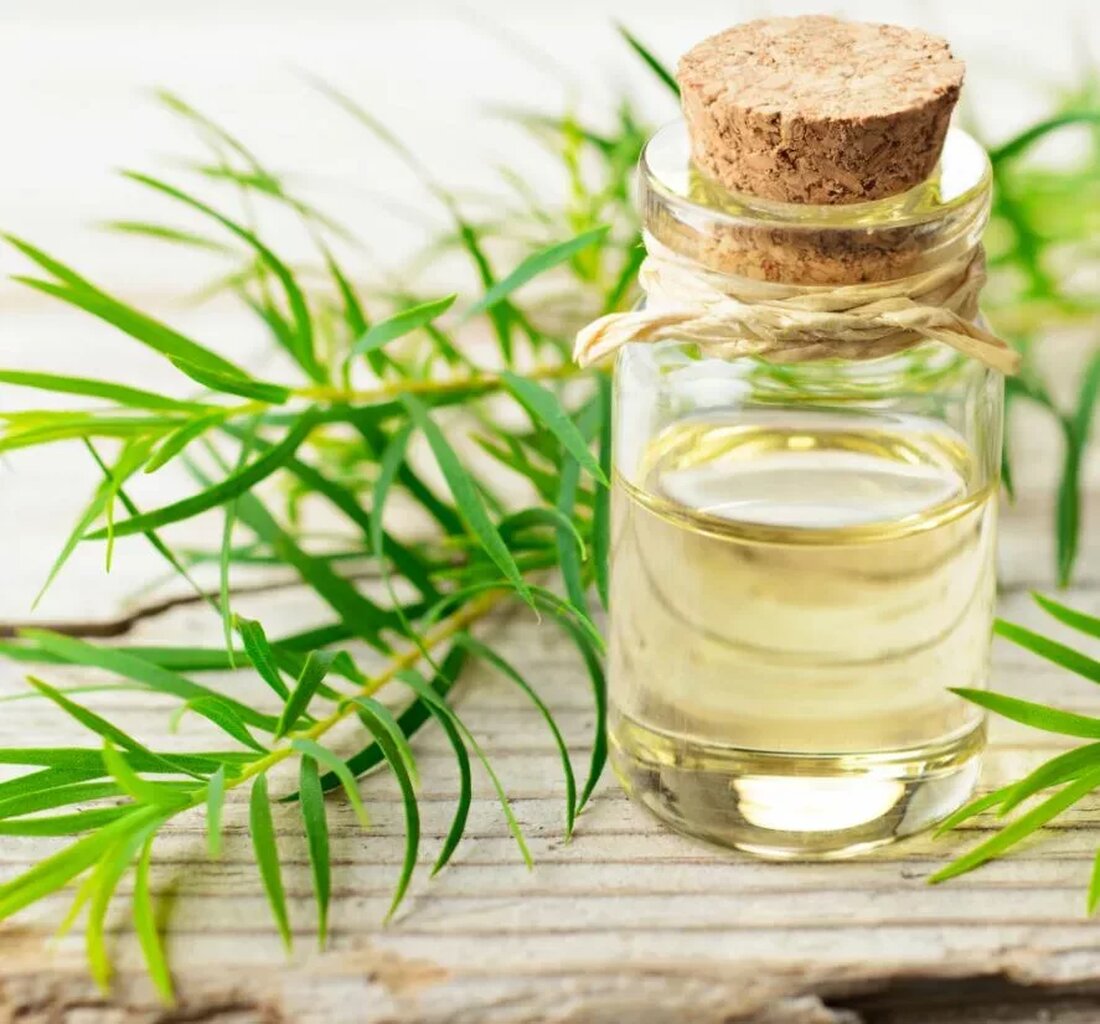Tea Tree Oil - Benefits, Uses, Recipes & Side Effects
From antiseptic mouthwash to natural deodorant, tea tree oil is an essential oil with a variety of uses and benefits. It tends to be light yellow or colorless, with an aroma similar to eucalyptus or camphor and has antibacterial, antiprotozoal, antiviral, anti-inflammatory and antifungal properties. Here's a deep dive into everything it can do. What is tea tree oil? Tea tree oil is distilled from the leaves of an evergreen shrub called Melaleuca alternifolia. The plant comes from Australia and is used by Aboriginal people to clean wounds and other skin problems. Benefits of Tea Tree Oil Tea tree oil has a 100-year history as a natural remedy. The Aboriginal people of Bundjalung crushed the leaves to make a paste that...

Tea Tree Oil - Benefits, Uses, Recipes & Side Effects
From antiseptic mouthwash to natural deodorant, tea tree oil is an essential oil with a variety of uses and benefits. It tends to be light yellow or colorless, with an aroma similar to eucalyptus or camphor and has antibacterial, antiprotozoal, antiviral, anti-inflammatory and antifungal properties. Here's a deep dive into everything it can do.
What is tea tree oil?
Tea tree oil is made from the leaves of an evergreen shrub called Melaleuca alternifoliadistilled. The plant comes from Australia and is used by Aboriginal people to clean wounds and other skin problems.
Benefits of Tea Tree Oil
Tea tree oil has a 100-year history as a natural remedy. Bundjalung Aboriginal people crushed the leaves to make a paste that could be applied to the skin. They also made tea from the leaves to relieve sore throats. Here's a look at how this oil can help you today. ((link removed))
Amazing antibacterial properties
The antibacterial properties of tea tree oil have been studied since the 1940s. Bacteria, including Streptococcus pyogenes (Strep) and Escherichia coli(E.coli), were tested in the laboratory to see how they react to the oil. The researchers found that the oil can target and destroy the cell membranes of bacteria. ((link removed))
Tea tree oil could play a helpful role against antibiotic resistance. Bacteria are becoming more resistant to antibiotics, so finding alternative solutions is crucial. In several experiments, bacteria showed no resistance to tea tree oil. ((link removed))
Healing & anti-inflammatory properties
Tea tree oil contains the compound terpinen-4-ol (an isomer of terpineol). Terpinen-4-ol is associated with anti-inflammatory effects. An experiment found that this substance can reduce inflammation caused by mites attacking the skin and eyes. This compound was able to suppress the production of pro-inflammatory cytokines, which are signaling molecules that promote inflammation in the body. ((link removed))
Surprising antifungal properties
Another benefit of this essential oil is its antifungal properties. It can be helpful in getting rid of fungi such as mold, ringworm, or nail fungus. Researchers focused on tea tree oil's ability to combat the overgrowth of Candida, a type of yeast. It appears to attack the yeast's cell membranes, damaging them and rendering them unable to function. Here too, the active component in tea tree oil, terpinen-4-ol, plays a role in destroying fungi. However, it is not the only compound, as 1,8-cineole also contributes to the breakdown of cell membranes. ((Link removed), (Link removed))
Unique antiprotozoan properties
Protozoa are single-celled organisms like amoebas. Many are parasitic and can cause infections in humans. For example, this causes protozoan Plasmodium falciparum Malaria and kills 660,000 people every year. In several studies, tea tree oil has shown that it can kill protozoa. This antiprotozoal activity is linked to terpinen-4-ol. ((Link removed), (Link removed))
Useful antiviral properties
Researchers have discovered antiviral properties in tea tree oil. A study at Heidelberg University focused on the herpes simplex virus, which can cause cold sores, and showed that tea tree oil reduced the overall viral load from infections. Another study at the University of Catania in Italy examined the ability of tea tree oil to prevent influenza virus replication. Once again, the compounds terpinen-4-ol and 1,8-cineole appear to be crucial for these activities. ((Link removed), (Link removed))
The Top 5 Tea Tree Oil Uses
For more than a century, people have used this oil for various ailments, from eczema to athlete's foot. Although researchers are still trying to study the full spectrum of tea tree oil uses, the following benefits have been measured.
1. Improve your hair
Some of the most popular tea tree oil uses are for hair. For example, a study at the Royal Prince Alfred Hospital in Australia found that a 5 percent tea tree oil shampoo resulted in a 41 percent improvement in dandruff. In addition to reducing dandruff, the essential oil can help suffocate head lice. The shampoo also reduced greasiness and itching. ((Link removed), (Link removed))
According to the National Psoriasis Foundation, some people find relief from scalp psoriasis by using tea tree oil shampoo. ((link removed))
You can purchase tea tree oil shampoo or make your own. One of the easiest methods is to add the essential oil to your existing shampoo.
Ingredients
- Ihre Lieblings-Shampoo
- Ätherisches Teebaumöl
preparation
- Fügen Sie zwei Tropfen ätherisches Teebaumöl pro 30 ml. Ihres Shampoos hinzu.
- Stellen Sie sicher, dass der Deckel sicher auf der Shampooflasche sitzt.
- Kräftig schütteln.
- Verwenden Sie das Shampoo wie gewohnt.
- Spülen Sie Ihre Haare mit Wasser.
Remember that tea tree essential oil is highly concentrated and should never be used directly on the scalp. Always dilute it by mixing it with shampoo or a carrier oil such as olive oil, coconut oil or aloe vera.
Our purchase recommendation: (link removed)
2. Promote a clear complexion
Tea tree oil is found in many skin care products, such as face washes. A Royal Prince Alfred Hospital study comparing 5 percent tea tree oil gel with 5 percent benzoyl peroxide lotion found that both products improved acne. Although tea tree oil had a slower onset, it also had fewer side effects. In another study, researchers compared 5 percent tea tree oil gel with placebo and found a significant improvement in acne in those who used the gel. ((Link removed), (Link removed))
Since we recommend using skin care products that are free of harsh chemicals, you can create a simple recipe here:
Ingredients
- Roher Honig
- Ätherisches Teebaumöl
preparation
- Fügen Sie einem Esslöffel Honig zwei Tropfen ätherisches Teebaumöl hinzu.
- Mischen Sie die Zutaten, um eine Paste zu erstellen.
- Auf dein Gesicht auftragen. Vermeiden Sie Augen und Mund.
- 5 bis 10 Minuten einwirken lassen.
- Waschen Sie Ihr Gesicht mit Wasser.
Try to find raw, organic, and natural honey without added chemicals that can irritate the skin. You can also add a small amount of baking soda, like half a teaspoon, to the paste for an extra antibacterial boost against blemishes.
Our purchase recommendation: (link removed)
3. Soothes eczema
Many of the common tea tree oils focus on treating skin conditions, including eczema. When researchers at Sweden's Skåne University Hospital compared tea tree oil with other topical products for treating skin problems, they found it to be effective. The calming effects of terpinen-4-ol in this essential oil may also help reduce the irritation caused by eczema. ((Link removed), (Link removed))
Skin ointments, creams, and gels containing tea tree oil can be purchased, but you can also create your own.
Ingredients
- Trägeröl wie Oliven-, Kokos-, Jojoba- oder anderes Öl
- Ätherisches Teebaumöl
preparation
- Da Sie unverdünntes ätherisches Teebaumöl nicht direkt auf die Haut auftragen können, müssen Sie es mit einem Trägeröl mischen. Geeignete Optionen sind Oliven, Kokosnuss, Jojoba oder ein anderes Öl.
- Fügen Sie einen Tropfen ätherisches Teebaumöl pro 12 Tropfen Trägeröl hinzu. Vermische sie.
- Auf die Haut auftragen und dabei Augen und Mund meiden.
Our purchase recommendation: (link removed)
4. Get rid of bad breath
One benefit of tea tree oil is its ability to eliminate bad breath or halitosis. Usually, bad breath is caused by bacteria, so the antibacterial properties of this essential oil can help get rid of it. When researchers in India compared different essential oils and examined the use of tea tree oil, they found that its use resulted in a significant reduction in oral bacteria. ((link removed))
It's important to remember that you don't want to swallow tea tree oil. It is not safe to take as it can cause serious concerns such as confusion and loss of muscle coordination. ((link removed))
You can find toothpaste and mouthwash that contain tea tree oil as an ingredient. You can also add it to your regular toothpaste or mouthwash.
Ingredients
- Ihre Lieblingsfluorid-freie Zahnpasta oder Mundwasser
- Ätherisches Teebaumöl
preparation
- Geben Sie einen Tropfen Teebaumöl in die Zahnpasta Ihrer Zahnbürste.
- Fügen Sie einer Tasse Mundwasser zwei Tropfen ätherisches Teebaumöl hinzu.
- Verwenden Sie die Produkte wie gewohnt.
- Spülen Sie Ihren Mund mit Wasser aus.
Our purchase recommendation: (link removed)
5. Fight against athlete's foot
Researchers at the Royal Prince Alfred Hospital studied 104 patients and found that a cream containing 10 percent tea tree oil was as effective as 1 percent tolnaftate in relieving symptoms of athlete's foot. Another study at the same hospital showed that patients who used a 25 percent or 50 percent tea tree oil solution showed improvement in their athlete's foot symptoms. ((Link removed), (Link removed))
Although there are over-the-counter creams and ointments for fungal infections, it's easy to make your own natural formula.
Ingredients
- Trägeröl wie Oliven, Kokos oder Jojoba
- Ätherisches Teebaumöl
preparation
- Tragen Sie unverdünntes ätherisches Teebaumöl nicht direkt auf die Haut auf, sondern mischen Sie es mit einem Trägeröl wie Oliven-, Kokos- oder Jojobaöl.
- Fügen Sie einen Tropfen ätherisches Teebaumöl pro 12 Tropfen Trägeröl hinzu. Vermische sie.
- Einen Tropfen Oreganoöl hinzufügen und mischen.
- Auf die Haut auftragen.
- Waschen Sie Ihre Hände gründlich und vermeiden Sie es, Ihre Augen oder Ihren Mund zu berühren.
Our purchase recommendation: (link removed)
How to apply tea tree oil
As mentioned earlier, you need to use a diluted form of tea tree oil. Never apply undiluted oil in concentrated form directly to the skin. It is best to dilute it with a suitable carrier such as jojoba or coconut oil. You can do this by adding one drop of tea tree oil to 12 drops of carrier oil.
Dermatologists recommend that people with sensitive skin use this product with caution. In some cases it can worsen skin irritation. Apply it to a small patch of skin first to check for any reactions.
Due to widespread knowledge about the benefits of tea tree oil, it is now available in many products. You can find it in shampoos, conditioners, lotions, creams, gels, bath oils, and ointments. However, the essential oil version is the most versatile because you can dilute it and add it to many products.
Are there any side effects of using tea tree oil?
In general, most tea tree oil uses are considered safe and have no serious side effects. In rare cases, people develop an allergic reaction, rash, or irritation after use. If you notice any concerns, stop use immediately and contact your doctor. ((link removed))
There are many practical uses for tea tree oil and it is far from the only essential oil that has a lot to offer.
Buy tea tree oil
Our purchase recommendation (tea tree oil for humidifiers): (link removed)
Our purchase recommendation (tea tree oil for oral hygiene): (link removed)
Our purchase recommendation (use on the skin): (link removed)
Our purchase recommendation (tea tree oil face mask): (link removed)

 Suche
Suche
 Mein Konto
Mein Konto
